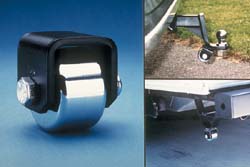I've made some progress on my trailer frame design but I am to the part where I need to design in the drop floor. I prefer the drop floors that come out all the way to the side of the trailer (like Doug's trailer) so you don't have to step down into them. My question is how do you determine how much you can safely drop the floor? I am guessing that wheel size and axle probably play a role in determining this but what is the minimum clearance etc that I should have?
thanks,
Lori
How do you determine depth of dropped floor on canned ham?
8 posts
• Page 1 of 1
Lori...I asked an open question for just how low people had their dropped floors on either a canned ham or a tear. From the ground to the bottom of the 2x longsill (doorside) on the frame I'm at 6 5/8" when level. This is the lowest point on mine. A flexiride axle is a real + as it's very difficult to determine the exact height if you don't have a fixed weight in mind. You can adjust the axle to bring it up a bit as well as make the dropped floor extend further back and wider since you don't have to deal with spring hangers and their bolts.
Other variables...wheel diameter and in my case, garage interior and garage door height. I've only got a 5" drop on the floor in mine, others are deeper, but I didn't want a really tall trailer. If you go with a short design, you will also need to get the correct tongue jack. Too tall on the mount and you won't be able to get it level, or pull the dolly wheel when it's on the hitch ball and run the risk of dragging it, if the frame sits low. I got one that is a jack only, no mounting system and created my own to customize the jack height.
I worried about dragging something, but so far, haven't had any issues with it being too low and the trip into DMV parking lot was risky, but no drag.
On a side note....it would be to your advantage to install some skid type plates on some of the portions that could drag as insurance. Scotties had them. Doug
Other variables...wheel diameter and in my case, garage interior and garage door height. I've only got a 5" drop on the floor in mine, others are deeper, but I didn't want a really tall trailer. If you go with a short design, you will also need to get the correct tongue jack. Too tall on the mount and you won't be able to get it level, or pull the dolly wheel when it's on the hitch ball and run the risk of dragging it, if the frame sits low. I got one that is a jack only, no mounting system and created my own to customize the jack height.
I worried about dragging something, but so far, haven't had any issues with it being too low and the trip into DMV parking lot was risky, but no drag.
On a side note....it would be to your advantage to install some skid type plates on some of the portions that could drag as insurance. Scotties had them. Doug
- doug hodder
- *Snoop Dougie Doug
- Posts: 12625
- Images: 562
- Joined: Tue Dec 14, 2004 11:20 pm


